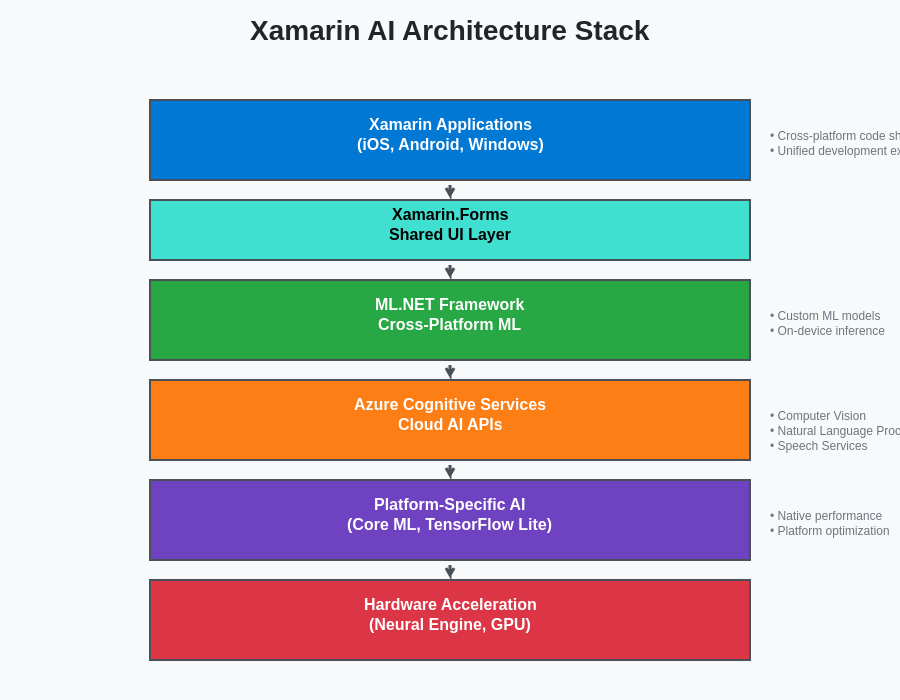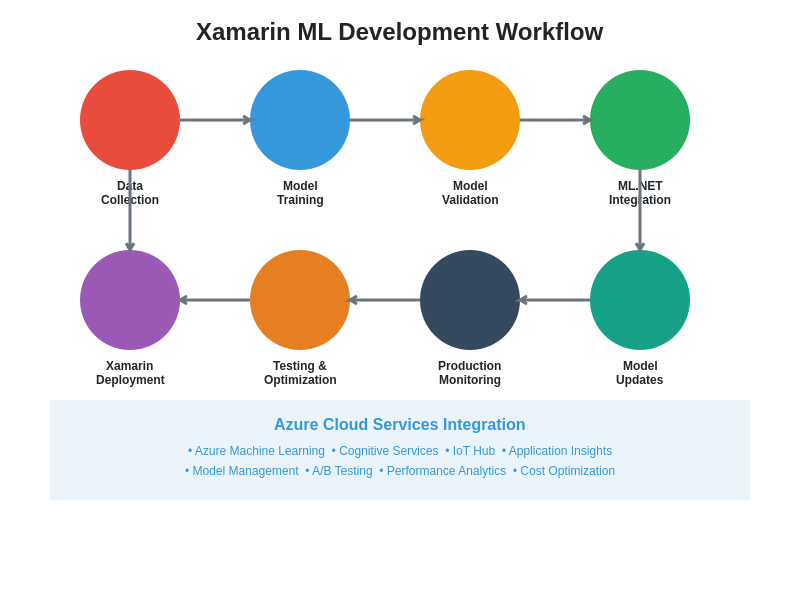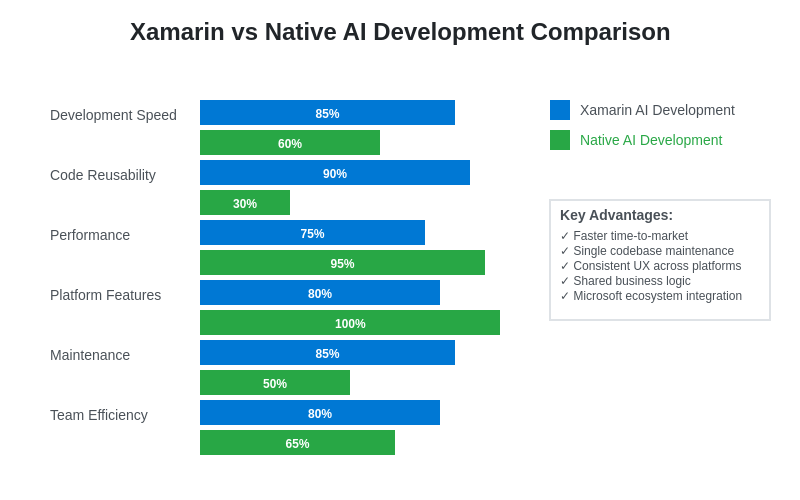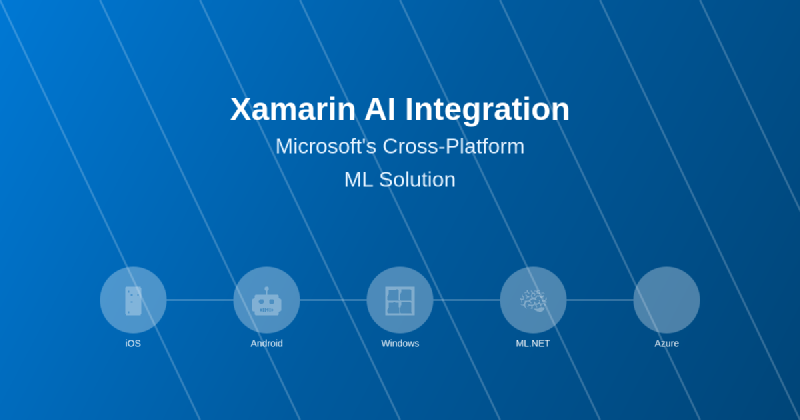The convergence of artificial intelligence and mobile application development has reached a pivotal moment with Microsoft’s Xamarin platform offering unprecedented opportunities for developers to integrate sophisticated machine learning capabilities across multiple platforms simultaneously. This revolutionary approach to cross-platform AI development has transformed how enterprises and independent developers conceptualize, build, and deploy intelligent mobile applications that can leverage the full spectrum of Microsoft’s AI ecosystem while maintaining native performance characteristics across iOS, Android, and Windows environments.
Explore the latest AI development trends that are shaping the future of cross-platform mobile development and discover how industry leaders are leveraging these technologies to create innovative solutions. The integration of AI capabilities into mobile applications through Xamarin represents a fundamental shift in how developers approach intelligent application development, enabling the creation of sophisticated solutions that were previously achievable only through platform-specific development approaches.
The Xamarin AI Ecosystem Architecture
Microsoft’s Xamarin platform has evolved into a comprehensive ecosystem that seamlessly integrates with the company’s extensive AI and machine learning infrastructure, creating an unparalleled development environment for cross-platform intelligent applications. The architecture encompasses multiple layers of AI integration, from low-level machine learning model execution to high-level cognitive services integration, all unified under a single development framework that enables code sharing across platforms while maintaining access to platform-specific AI capabilities.
The foundation of Xamarin’s AI integration lies in its ability to leverage ML.NET, Microsoft’s cross-platform machine learning framework, which provides developers with the tools necessary to build, train, and deploy custom machine learning models directly within mobile applications. This integration enables sophisticated on-device inference capabilities that can operate independently of network connectivity while maintaining the privacy and security benefits of local processing. The seamless integration between Xamarin and ML.NET has democratized access to advanced machine learning capabilities for mobile developers who may not have extensive background in data science or machine learning engineering.

The comprehensive architecture stack demonstrates how Xamarin seamlessly integrates multiple layers of AI and ML capabilities, from high-level application frameworks down to hardware-accelerated processing units. This layered approach ensures optimal performance while maintaining development simplicity and cross-platform compatibility.
Furthermore, the Xamarin ecosystem provides native bindings to platform-specific AI frameworks such as Core ML on iOS and TensorFlow Lite on Android, enabling developers to leverage the full performance potential of each platform’s optimized machine learning infrastructure. This hybrid approach combines the efficiency of cross-platform development with the performance benefits of platform-native AI execution, creating applications that deliver exceptional user experiences while maintaining development efficiency and code reusability across multiple target platforms.
Azure Cognitive Services Integration
The integration of Azure Cognitive Services within Xamarin applications represents one of the most compelling aspects of Microsoft’s cross-platform AI strategy, providing developers with immediate access to production-ready AI capabilities without requiring extensive machine learning expertise or infrastructure management. These cloud-based services encompass a comprehensive range of AI functionalities including computer vision, natural language processing, speech recognition and synthesis, decision-making algorithms, and knowledge mining capabilities that can be seamlessly integrated into mobile applications through well-documented APIs and SDK integrations.
Enhance your development workflow with Claude’s AI assistance to accelerate the integration of complex AI services and streamline the development process for intelligent cross-platform applications. The combination of human expertise and AI-powered development tools creates an environment where sophisticated AI integration becomes accessible to developers across different skill levels and experience backgrounds.
The computer vision capabilities available through Azure Cognitive Services enable Xamarin applications to implement sophisticated image recognition, object detection, facial recognition, and optical character recognition features that can transform static visual content into actionable intelligence. These capabilities are particularly valuable for enterprise applications that require document processing, inventory management, quality assurance, or security authentication features. The seamless integration of these services through Xamarin enables developers to create applications that can process and analyze visual content in real-time while maintaining consistent functionality across different mobile platforms.
Natural language processing integration through Azure Cognitive Services empowers Xamarin applications with advanced text analysis, sentiment analysis, language translation, and conversational AI capabilities that can significantly enhance user engagement and application intelligence. These features enable the development of applications that can understand and respond to natural language input, analyze user sentiment and feedback, provide real-time translation services, and implement sophisticated chatbot functionality that enhances user interaction and support capabilities.
ML.NET Framework Integration
The integration of ML.NET within Xamarin applications has revolutionized how developers approach machine learning implementation in cross-platform mobile development, providing a comprehensive framework for building, training, and deploying custom machine learning models that can operate efficiently on mobile devices. This integration enables developers to create applications with sophisticated predictive analytics, recommendation systems, anomaly detection, and classification capabilities that can function independently of cloud connectivity while maintaining high performance and accuracy standards.
ML.NET’s support for various machine learning scenarios including binary classification, multi-class classification, regression, clustering, anomaly detection, and recommendation systems provides Xamarin developers with the flexibility to implement diverse AI-powered features within their applications. The framework’s ability to consume models trained using popular machine learning libraries such as TensorFlow, PyTorch, and ONNX ensures compatibility with existing machine learning workflows and enables integration of pre-trained models developed by data science teams using their preferred tools and methodologies.
The AutoML capabilities integrated within ML.NET significantly lower the barrier to entry for developers who may not have extensive machine learning background but want to incorporate intelligent features into their applications. These automated machine learning features can analyze datasets, recommend appropriate algorithms, perform hyperparameter tuning, and generate optimized models that can be directly integrated into Xamarin applications without requiring deep understanding of machine learning theory or model optimization techniques.

The comprehensive development workflow illustrates the complete lifecycle of ML integration within Xamarin applications, from initial data collection through production deployment and ongoing model management. This systematic approach ensures quality, performance, and maintainability throughout the AI development process.
Cross-Platform Model Deployment Strategies
The deployment of machine learning models across multiple platforms through Xamarin requires careful consideration of platform-specific constraints, performance requirements, and user experience expectations. Microsoft’s approach to cross-platform model deployment encompasses multiple strategies that enable developers to optimize their AI implementations for different scenarios while maintaining code reusability and development efficiency across target platforms.
On-device model deployment through Xamarin enables applications to perform machine learning inference locally without requiring network connectivity, providing benefits in terms of privacy, latency, and offline functionality. This approach is particularly valuable for applications that process sensitive data, require real-time response capabilities, or need to function in environments with limited or unreliable network connectivity. The integration of optimized model formats such as ONNX and platform-specific optimizations ensures that on-device inference can achieve acceptable performance levels even on resource-constrained mobile devices.
Cloud-based model deployment strategies leverage Azure Machine Learning services to provide scalable, high-performance inference capabilities that can handle complex models and large-scale processing requirements. This approach is ideal for applications that require access to sophisticated models that exceed mobile device computational capabilities or need to process large volumes of data that would be impractical to handle on-device. The seamless integration between Xamarin applications and Azure Machine Learning services enables hybrid deployment strategies that combine the benefits of both on-device and cloud-based processing depending on specific use case requirements.
Discover advanced AI research capabilities with Perplexity to stay informed about the latest developments in cross-platform AI deployment strategies and emerging technologies that are shaping the future of mobile machine learning applications. The rapid evolution of this field requires continuous learning and adaptation to leverage new capabilities and optimization techniques as they become available.
Performance Optimization and Platform-Specific Considerations
The optimization of AI-powered Xamarin applications requires deep understanding of platform-specific performance characteristics, hardware capabilities, and optimization techniques that can significantly impact user experience and application efficiency. Microsoft’s approach to cross-platform AI optimization encompasses multiple layers of performance tuning, from high-level algorithm selection to low-level hardware acceleration integration that ensures optimal performance across diverse device configurations and platform ecosystems.
Memory management represents one of the most critical aspects of AI application optimization in mobile environments, where memory constraints can significantly impact both application performance and user experience. Xamarin’s integration with platform-specific memory management systems enables developers to implement sophisticated memory optimization strategies that can efficiently handle large machine learning models and datasets while maintaining responsive user interfaces and preventing memory-related application crashes or performance degradation.
Hardware acceleration integration through Xamarin enables applications to leverage platform-specific AI processing capabilities such as Apple’s Neural Engine, Qualcomm’s AI Engine, and various GPU acceleration frameworks that can dramatically improve inference performance and energy efficiency. The abstraction layer provided by Xamarin ensures that developers can implement hardware acceleration features through unified APIs while maintaining compatibility across different device configurations and hardware architectures.
Battery life optimization represents another crucial consideration for AI-powered mobile applications, as machine learning operations can consume significant computational resources and impact device battery performance. Xamarin’s integration with platform-specific power management systems enables developers to implement intelligent scheduling strategies, adaptive processing capabilities, and energy-efficient algorithms that balance AI functionality with battery life considerations to ensure sustainable application performance.
Real-World Implementation Patterns
The practical implementation of AI capabilities within Xamarin applications follows established patterns and best practices that have emerged from extensive real-world deployment experience across diverse industries and use cases. These implementation patterns provide developers with proven approaches to common AI integration challenges while maintaining code quality, performance standards, and maintainability requirements that are essential for production applications.
The Model-View-ViewModel (MVVM) pattern, which is fundamental to Xamarin development, can be effectively extended to accommodate AI integration by creating specialized view models that encapsulate machine learning logic and data processing workflows. This approach ensures separation of concerns between AI functionality and user interface components while maintaining testability and maintainability of AI-powered features. The implementation of AI-specific view models enables developers to create reusable components that can be easily integrated across different application screens and workflows.
Dependency injection patterns play a crucial role in AI-enabled Xamarin applications by enabling flexible integration of different AI services, model providers, and processing strategies without creating tight coupling between application components. This approach facilitates testing, enables easy switching between different AI service providers, and supports the implementation of fallback strategies when primary AI services are unavailable or encounter errors.
Asynchronous programming patterns are essential for AI integration within Xamarin applications, as machine learning operations often require significant processing time that could block user interface responsiveness if not properly managed. The implementation of async/await patterns, background processing strategies, and progress reporting mechanisms ensures that AI-powered features enhance rather than degrade user experience by maintaining responsive interfaces during intensive computational operations.
Security and Privacy Considerations
The integration of AI capabilities within mobile applications raises significant security and privacy concerns that must be carefully addressed through comprehensive security strategies and privacy-preserving implementation approaches. Microsoft’s Xamarin platform provides multiple layers of security integration that enable developers to implement robust protection mechanisms while maintaining the functionality and performance benefits of AI-powered features.
Data privacy protection represents a fundamental requirement for AI-enabled mobile applications, particularly when processing sensitive user data or personal information. Xamarin’s integration with platform-specific privacy frameworks enables developers to implement comprehensive data protection strategies that include encryption, secure storage, data anonymization, and user consent management capabilities that comply with regulatory requirements such as GDPR, CCPA, and other privacy legislation.
On-device processing capabilities provided through Xamarin AI integration offer significant privacy advantages by enabling applications to perform machine learning inference locally without transmitting sensitive data to external services. This approach is particularly valuable for applications that process personal information, biometric data, or confidential business information where data privacy and security requirements prohibit cloud-based processing approaches.
Secure communication protocols and authentication mechanisms ensure that when cloud-based AI services are utilized, data transmission and service access are properly protected through industry-standard security practices. Xamarin’s integration with Azure security services provides comprehensive identity management, access control, and encryption capabilities that protect both data in transit and data at rest while maintaining the performance and functionality requirements of AI-powered applications.
Development Workflow and Tooling Integration
The development workflow for AI-enabled Xamarin applications has been significantly enhanced through Microsoft’s comprehensive tooling ecosystem that provides integrated development experiences, debugging capabilities, testing frameworks, and deployment automation that streamline the development process from initial prototyping through production deployment. This integrated approach reduces the complexity traditionally associated with AI application development while maintaining the flexibility and control required for sophisticated implementation scenarios.
Visual Studio’s integration with Xamarin and AI development tools provides developers with comprehensive debugging and profiling capabilities that enable detailed analysis of AI model performance, memory usage, and computational efficiency. These tools are essential for optimizing AI-powered features and identifying performance bottlenecks that could impact user experience or application stability. The integration of AI-specific debugging tools enables developers to trace model execution, analyze inference results, and optimize processing workflows without requiring separate debugging environments or external tools.
Continuous integration and deployment pipelines specifically designed for AI-enabled Xamarin applications provide automated testing, model validation, and deployment capabilities that ensure consistent quality and performance across different deployment environments. These pipelines can automatically validate model accuracy, test AI feature functionality, and deploy applications with confidence that AI capabilities will function correctly in production environments.
Testing frameworks and methodologies for AI-enabled applications require specialized approaches that can validate both traditional application functionality and AI-specific behaviors such as model accuracy, inference performance, and edge case handling. Xamarin’s integration with comprehensive testing frameworks enables developers to implement automated testing strategies that cover the full spectrum of application functionality while ensuring that AI features meet quality and performance requirements.

The performance analysis demonstrates the compelling advantages of Xamarin for AI development, particularly in areas of development speed, code reusability, and maintenance efficiency. While native development may offer slight performance advantages, Xamarin provides superior overall value through accelerated development cycles and reduced maintenance overhead.
Enterprise Integration and Scalability
The enterprise adoption of AI-enabled Xamarin applications requires consideration of scalability, integration, and management requirements that extend beyond individual application development to encompass organizational AI strategy, infrastructure requirements, and governance frameworks. Microsoft’s comprehensive enterprise AI ecosystem provides the foundation for large-scale deployment of intelligent mobile applications that can integrate seamlessly with existing enterprise systems and workflows.
Integration with enterprise identity and access management systems ensures that AI-powered mobile applications can participate in organizational security frameworks while maintaining user convenience and application functionality. Xamarin’s integration with Azure Active Directory and other enterprise identity systems provides comprehensive authentication, authorization, and user management capabilities that enable sophisticated access control policies for AI-powered features and data.
Scalability considerations for enterprise AI applications encompass both technical and organizational aspects, including the ability to handle increasing user loads, model complexity, and data processing requirements while maintaining performance and reliability standards. The integration between Xamarin applications and Azure cloud services provides virtually unlimited scalability for AI processing workloads while maintaining cost efficiency and operational simplicity.
Governance and compliance frameworks for enterprise AI applications require comprehensive monitoring, auditing, and control capabilities that ensure responsible AI usage while maintaining business value and competitive advantages. Microsoft’s AI governance tools integrated with Xamarin applications provide detailed logging, monitoring, and compliance reporting capabilities that enable organizations to implement responsible AI practices while maximizing the business value of intelligent mobile applications.
Future Directions and Emerging Technologies
The evolution of AI integration within Xamarin applications continues to accelerate with emerging technologies and capabilities that promise to further enhance the power and accessibility of cross-platform intelligent mobile development. Microsoft’s continued investment in AI research and development ensures that Xamarin developers will have access to cutting-edge capabilities as they become available, maintaining the platform’s position as a leading solution for cross-platform AI application development.
Edge computing integration represents a significant opportunity for Xamarin AI applications, enabling more sophisticated on-device processing capabilities while maintaining connectivity to cloud-based services for complex processing tasks. The integration of edge computing frameworks with Xamarin applications will enable new categories of intelligent applications that can leverage distributed processing capabilities while maintaining responsive user experiences and efficient resource utilization.
Federated learning capabilities integrated within Xamarin applications will enable new approaches to machine learning that can leverage distributed data sources while maintaining privacy and security requirements. This technology has the potential to enable collaborative learning scenarios where multiple applications can contribute to model improvement without sharing sensitive data, creating opportunities for more accurate and robust AI capabilities.
The continued advancement of mobile hardware capabilities, including specialized AI processing units, advanced sensors, and improved computational power, will enable Xamarin applications to implement increasingly sophisticated AI features while maintaining energy efficiency and performance standards. The platform’s ability to leverage these hardware advances through unified development approaches ensures that developers can take advantage of new capabilities without requiring platform-specific expertise or separate development efforts.
Disclaimer
This article is for informational purposes only and does not constitute professional advice regarding software development, artificial intelligence implementation, or technology selection decisions. The information presented reflects current understanding of Microsoft Xamarin AI integration capabilities and may not account for future platform changes, updates, or discontinuations. Readers should conduct thorough evaluation of their specific requirements, consult with qualified professionals, and perform appropriate testing before implementing AI solutions in production environments. The effectiveness and suitability of AI integration approaches may vary significantly depending on specific use cases, technical requirements, regulatory constraints, and organizational capabilities.
